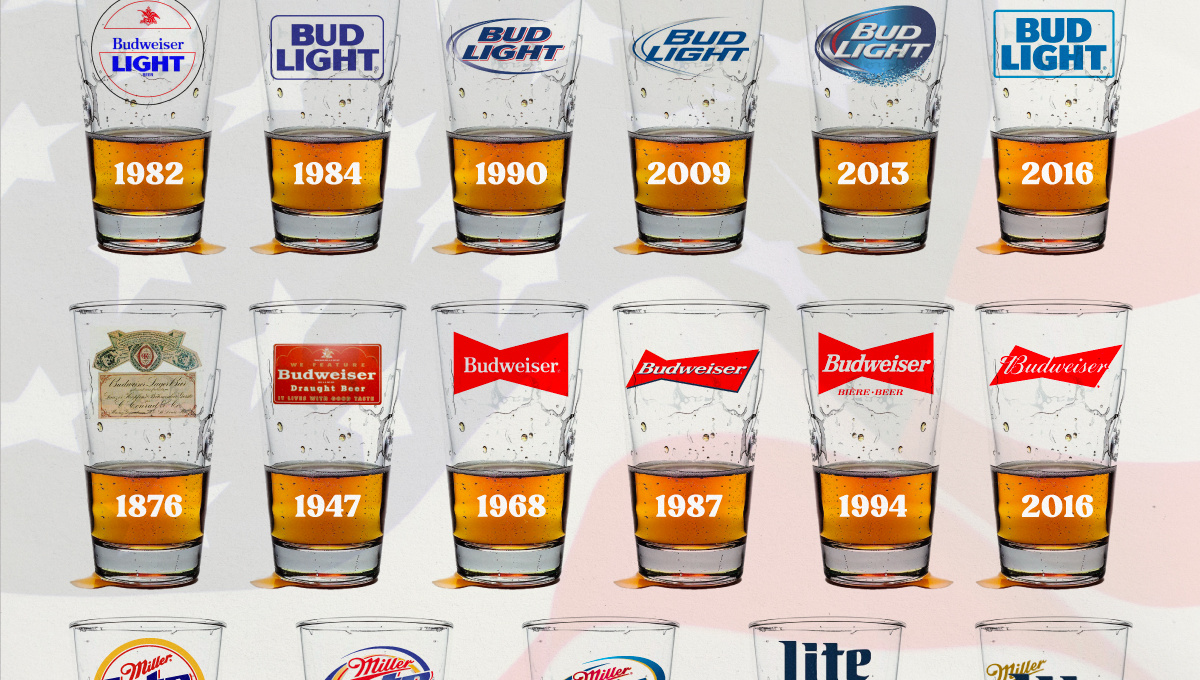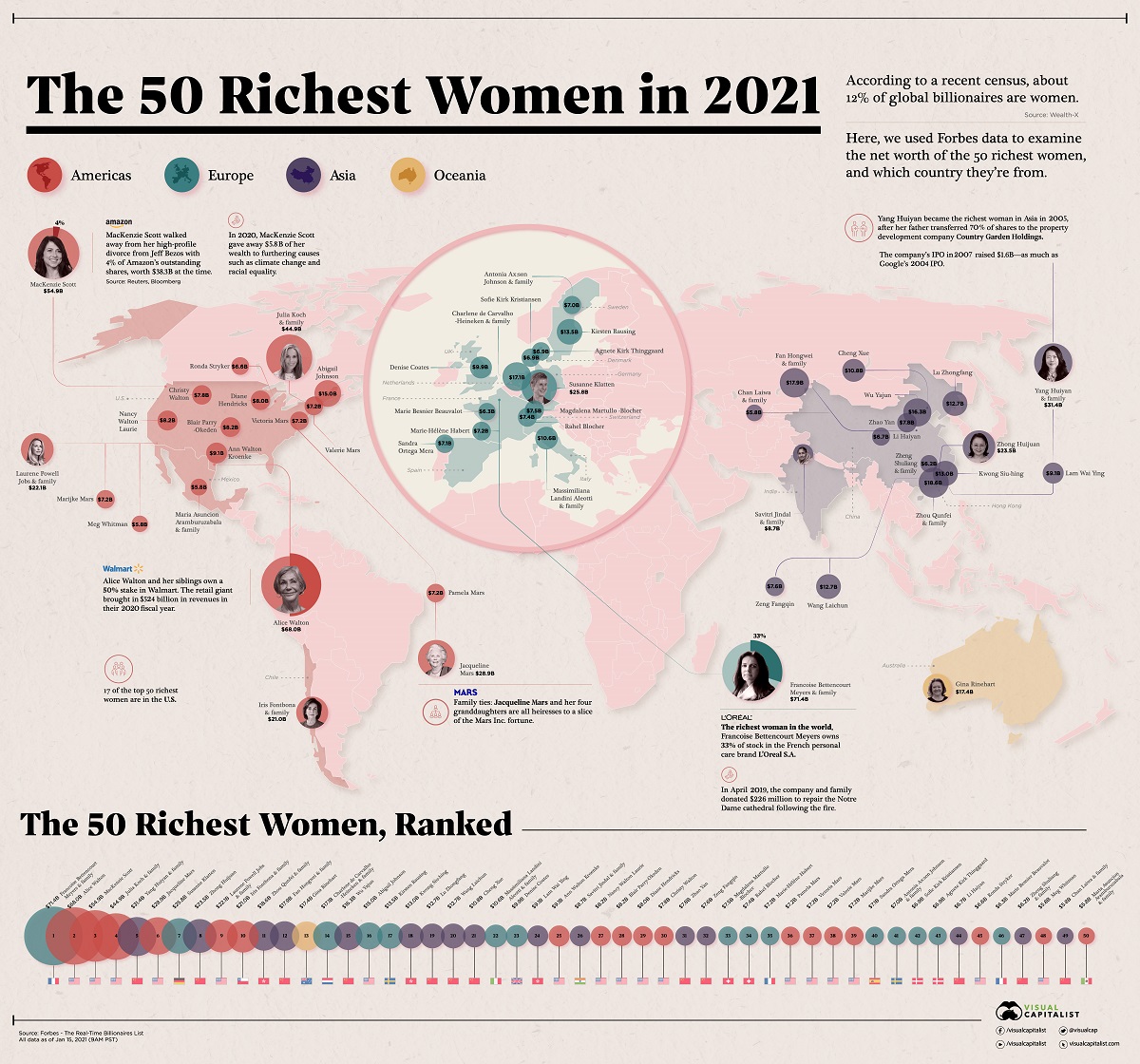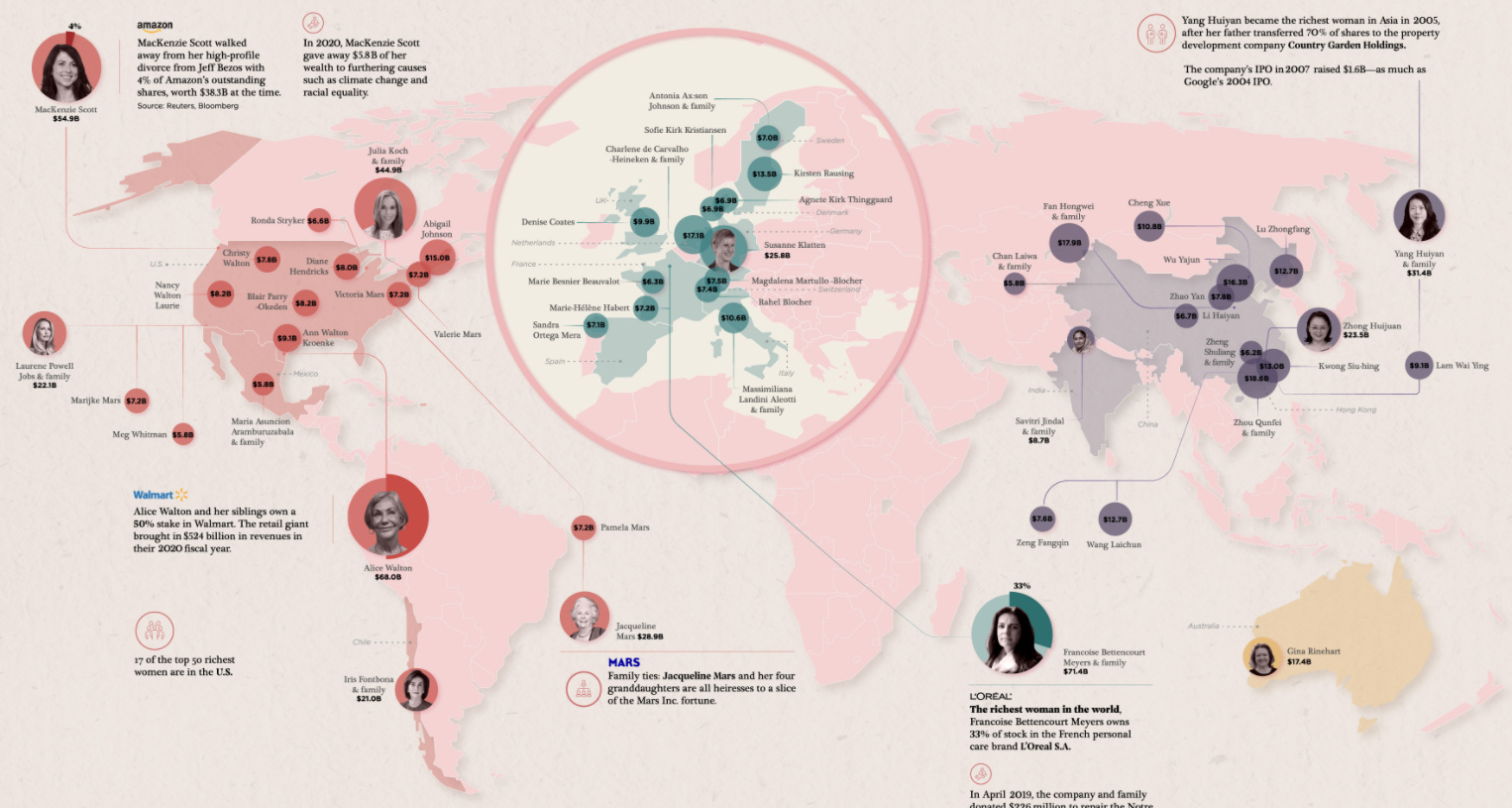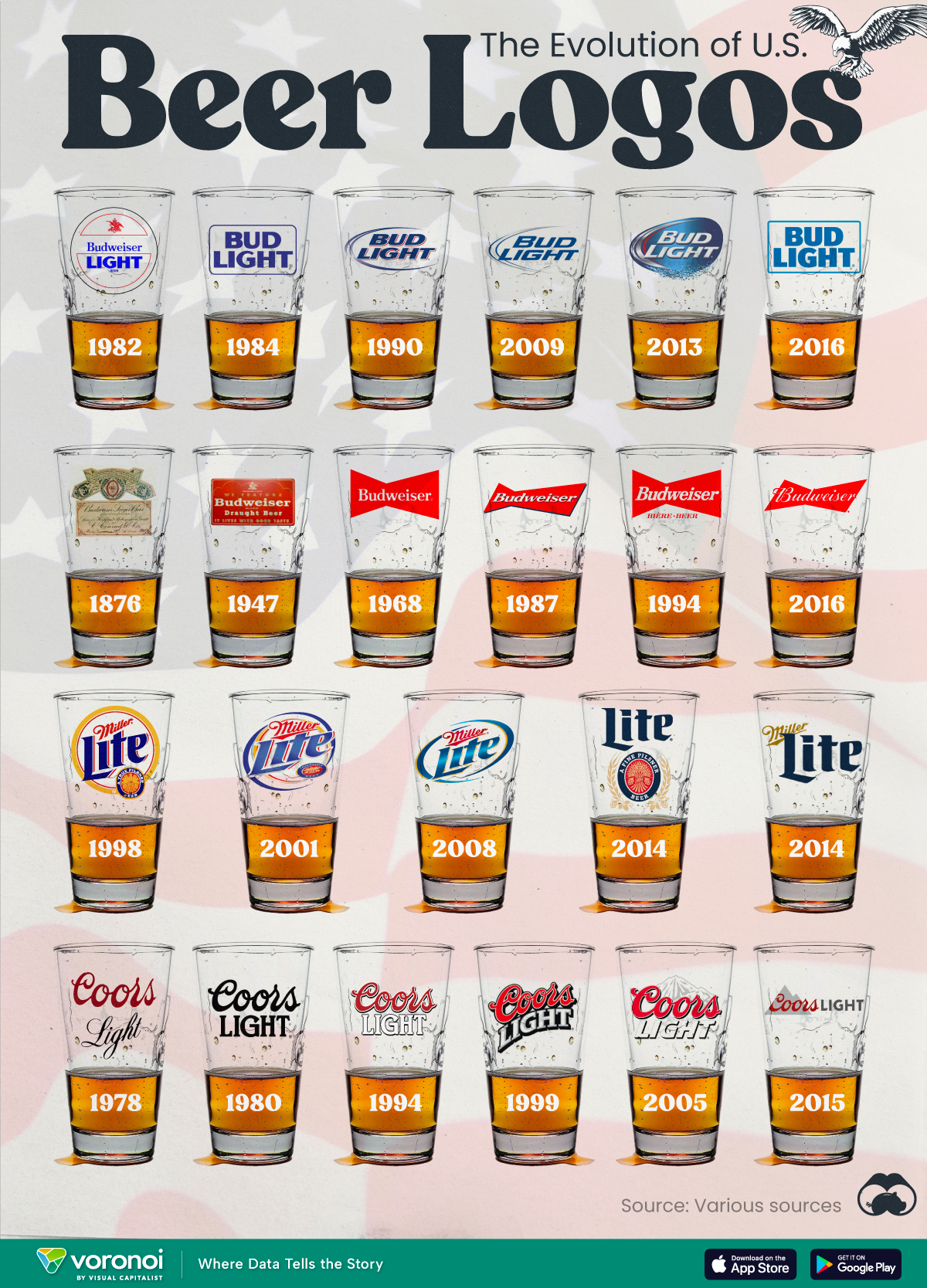Business
Mapped: The 50 Richest Women in the World in 2021
View the full-resolution version of this infographic
Mapped: The 50 Richest Women in the World in 2021
View the high-resolution of the infographic by clicking here.
According to a recent census by Wealth-X, 11.9% of global billionaires are women. Even at such a minority share, this group still holds massive amounts of wealth.
Using a real-time list of billionaires from Forbes, we examine the net worth of the 50 richest women in the world and which country they’re from.
Where are the World’s Richest Women?
The richest woman in the world, Francoise Bettencourt Meyers and family own 33% of stock in L’Oréal S.A., a French personal care brand. She is also the granddaughter of its founder.
In April 2019, L’Oréal and the Bettencourt Meyers family pledged $226 million (€200 million) towards the repair of the Notre Dame cathedral after its devastating fire.
Following closely behind is Alice Walton of the Walmart empire—also the world’s richest family. Together with her brothers, they own over 50% of the company’s shares. That’s a pretty tidy sum, considering Walmart raked in $524 billion in revenues in their 2020 fiscal year.
Other family ties among the richest women in the world include Jacqueline Mars and her four granddaughters, heiresses to a slice of the Mars Inc. fortune in candy and pet food—and all of them make this list.
| Rank | Name | Net Worth ($B) | Country |
|---|---|---|---|
| #1 | Francoise Bettencourt Meyers & family | $71.4 | 🇫🇷 France |
| #2 | Alice Walton | $68.0 | 🇺🇸 United States |
| #3 | MacKenzie Scott | $54.9 | 🇺🇸 United States |
| #4 | Julia Koch & family | $44.9 | 🇺🇸 United States |
| #5 | Yang Huiyan & family | $31.4 | 🇨🇳 China |
| #6 | Jacqueline Mars | $28.9 | 🇺🇸 United States |
| #7 | Susanne Klatten | $25.8 | 🇩🇪 Germany |
| #8 | Zhong Huijuan | $23.5 | 🇨🇳 China |
| #9 | Laurene Powell Jobs & family | $22.1 | 🇺🇸 United States |
| #10 | Iris Fontbona & family | $21.0 | 🇨🇱 Chile |
| #11 | Zhou Qunfei & family | $18.6 | 🇭🇰 Hong Kong |
| #12 | Fan Hongwei & family | $17.9 | 🇨🇳 China |
| #13 | Gina Rinehart | $17.4 | 🇦🇺 Australia |
| #14 | Charlene de Carvalho-Heineken & family | $17.1 | 🇳🇱 Netherlands |
| #15 | Wu Yajun | $16.3 | 🇨🇳 China |
| #16 | Abigail Johnson | $15.0 | 🇺🇸 United States |
| #17 | Kirsten Rausing | $13.5 | 🇸🇪 Sweden |
| #18 | Kwong Siu-hing | $13.0 | 🇭🇰 Hong Kong |
| #19 | Lu Zhongfang | $12.7 | 🇨🇳 China |
| #20 | Wang Laichun | $12.7 | 🇨🇳 China |
| #21 | Cheng Xue | $10.8 | 🇨🇳 China |
| #22 | Massimiliana Landini Aleotti & family | $10.6 | 🇮🇹 Italy |
| #23 | Denise Coates | $9.9 | 🇬🇧 United Kingdom |
| #24 | Lam Wai Ying | $9.1 | 🇭🇰 Hong Kong |
| #25 | Ann Walton Kroenke | $9.1 | 🇺🇸 United States |
| #26 | Savitri Jindal & family | $8.7 | 🇮🇳 India |
| #27 | Nancy Walton Laurie | $8.2 | 🇺🇸 United States |
| #28 | Blair Parry-Okeden | $8.2 | 🇺🇸 United States |
| #29 | Diane Hendricks | $8.0 | 🇺🇸 United States |
| #30 | Christy Walton | $7.8 | 🇺🇸 United States |
| #31 | Zhao Yan | $7.8 | 🇨🇳 China |
| #32 | Zeng Fangqin | $7.6 | 🇨🇳 China |
| #33 | Magdalena Martullo-Blocher | $7.5 | 🇨🇭 Switzerland |
| #34 | Rahel Blocher | $7.4 | 🇨🇭 Switzerland |
| #35 | Marie-Hélène Habert | $7.2 | 🇫🇷 France |
| #36 | Pamela Mars | $7.2 | 🇺🇸 United States |
| #37 | Victoria Mars | $7.2 | 🇺🇸 United States |
| #38 | Valerie Mars | $7.2 | 🇺🇸 United States |
| #39 | Marijke Mars | $7.2 | 🇺🇸 United States |
| #40 | Sandra Ortega Mera | $7.1 | 🇪🇸 Spain |
| #41 | Antonia Ax:son Johnson & family | $7.0 | 🇸🇪 Sweden |
| #42 | Sofie Kirk Kristiansen | $6.9 | 🇩🇰 Denmark |
| #43 | Agnete Kirk Thinggaard | $6.9 | 🇩🇰 Denmark |
| #44 | Li Haiyan | $6.7 | 🇨🇳 China |
| #45 | Ronda Stryker | $6.6 | 🇺🇸 United States |
| #46 | Marie Besnier Beauvalot | $6.3 | 🇫🇷 France |
| #47 | Zheng Shuliang & family | $6.2 | 🇨🇳 China |
| #48 | Meg Whitman | $5.8 | 🇺🇸 United States |
| #49 | Chan Laiwa & family | $5.8 | 🇨🇳 China |
| #50 | Maria Asuncion Aramburuzabala & family | $5.8 | 🇲🇽 Mexico |
All data as of January 15, 2021 (9AM PST)
MacKenzie Scott, ranked #3 on the list, was heavily involved in the early days of turning Amazon into an e-commerce behemoth. She was involved in areas from bookkeeping and accounts to negotiating the company’s first freight contract. Her high-profile divorce from Jeff Bezos captured the headlines, notably because she gained control over 4% of Amazon’s outstanding shares.
The total value of these shares? An eye-watering $38.3 billion—propelling her to the status of one of America’s richest people.
However, MacKenzie Scott has more altruistic ventures in mind for this wealth. In 2020, she gave away $5.8 billion towards causes such as climate change and racial equality in just four months, and is a signatory on the Giving Pledge.
[Scott’s near $6 billion donation has] to be one of the biggest annual distributions by a living individual.
—Melissa Berman, CEO of Rockefeller Philanthropy Advisors
Looking towards the East, Yang Huiyan became the richest woman in Asia after inheriting 70% of shares in the property development company Country Garden Holdings. The company went public in 2007, raising $1.6 billion in its IPO—an amount comparable to Google’s IPO in 2004.
To aid frontline health workers during the pandemic, Country Garden Holdings set up robotic, automated buffet stations to safely serve medical staff in Wuhan, China.
Giving Generously
While the 50 richest women in the world have certainly made progress, the overall tier of billionaires is still very much a boys’ club. One thing that also factors into this could be the way this wealth is spent.
As many female billionaires inherited their wealth, a large share are more inclined to contribute to charitable causes where they can use their money to make an impact. What percentage of billionaires by gender have contributed at least $1 million in donations over the past five years?
Made $1mm in donations over last 5 years (%)
| Source of wealth | 👩 Female philanthropists | 👨 Male philanthropists |
|---|---|---|
| Inherited | 68% | 5% |
| Inherited/Self-made | 20% | 28% |
| Self-made | 12% | 67% |
Source: Wealth-X
Meanwhile, male billionaires are more likely to donate to charity if they built the wealth themselves—and many companies that fall into this category certainly stepped up during the early days of the COVID-19 crisis.
Misc
The Evolution of U.S. Beer Logos
In this graphic, we analyze the evolution of popular U.S. beer logos like Budweiser, Coors Light, Bud Light, and more.

The Evolution of U.S. Beer Logos
This was originally posted on our Voronoi app. Download the app for free on iOS or Android and discover incredible data-driven charts from a variety of trusted sources.
Despite selling a popular product, beer companies have to be creative to stand out in a competitive market.
In this graphic, we analyze the evolution of some U.S. beer logos based on various sources. We chose brands based on a mixture of criteria, including popularity (based on YouGov surveys), availability of logo assets, and those with interesting developments.
Bud Light Back to the ’80s
Despite recent backlash and calls for a boycott after sending a commemorative can to transgender influencer Dylan Mulvaney, Bud Light remains one of America’s best-selling beers.
The brand of light beer, owned by the Anheuser-Busch company, has switched from its more circular logo with italic letters adopted in the 1990s back to the Bud Light badge of the 1980s. It is composed of heavy uppercase lettering, written in two levels in a shade of blue with the inscription placed on a solid white background and enclosed in a thin rectangular frame.
Miller Lite Goes Old School
After following a similar approach to Bud Light’s branding throughout the 2000s, Miller Lite decided to undergo a major rebranding in 2014.
The company returned to its 1970s roots, once again combining a white can with its original blue, gold, and red logo. The redesign was largely considered a success, given that Miller Lite sales immediately increased following the change.
A Symbol of American Brewing
The oldest brand on our U.S. beer list, the Budweiser logo, has undergone more than 15 changes over the years.
The design of two connected triangles represents a red bow tie, as a symbol of American brewing.
The colors of the Budweiser logo include a vibrant red, which helps the logo stand out and be easily recognizable from a distance. Studies also suggest that the color red stimulates appetite. Meanwhile, the white inscription symbolizes purity and cleanliness.
Curious to learn more about the beer market? Check out this graphic about global beer consumption.
-

 Markets5 days ago
Markets5 days agoVisualizing Global Inflation Forecasts (2024-2026)
-

 Green2 weeks ago
Green2 weeks agoThe Carbon Footprint of Major Travel Methods
-

 United States2 weeks ago
United States2 weeks agoVisualizing the Most Common Pets in the U.S.
-

 Culture2 weeks ago
Culture2 weeks agoThe World’s Top Media Franchises by All-Time Revenue
-

 voronoi1 week ago
voronoi1 week agoBest Visualizations of April on the Voronoi App
-

 Wealth1 week ago
Wealth1 week agoCharted: Which Country Has the Most Billionaires in 2024?
-

 Business1 week ago
Business1 week agoThe Top Private Equity Firms by Country
-

 Markets1 week ago
Markets1 week agoThe Best U.S. Companies to Work for According to LinkedIn



















